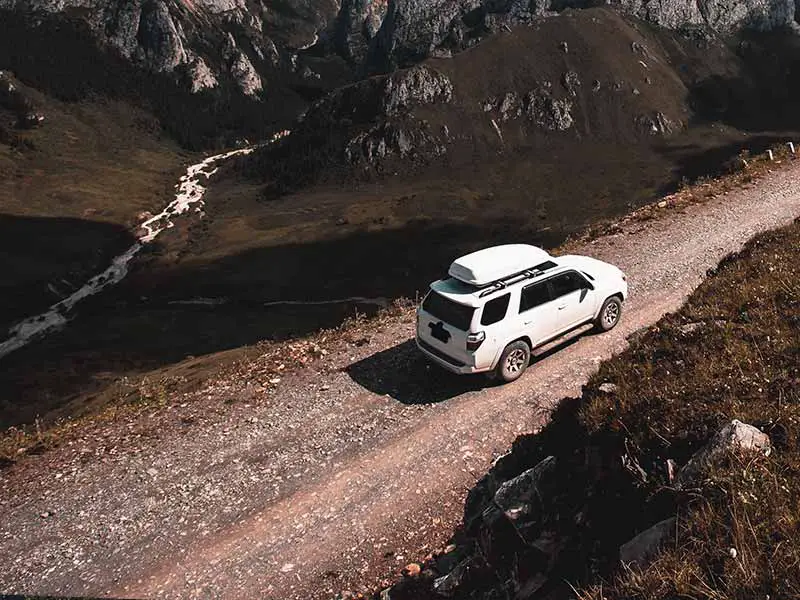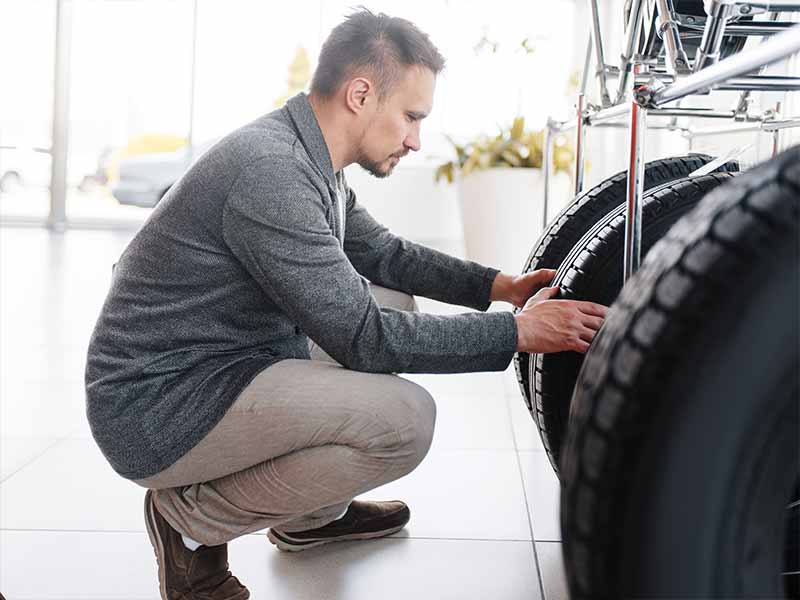Choosing the right tire for your truck can be tricky with all the different options and technical terms. Whether you drive mostly on smooth roads or like to venture off-road, understanding what all the tire terms mean helps you pick the best one for your adventures.
What Does AT Mean On A Tire?
AT on a tire means “All-Terrain,” which tells you the tire is made to work well on many types of surfaces, like regular roads and off-road paths. These tires have a special design that gives good grip on the highway and can also handle places like dirt trails pretty well.
In this article, we’ll talk all about AT tires, looking at what makes them special, and where they work best. We’ll also compare them with other kinds of truck tires (LT, HT, and MT) and chat about how they work in different weather like snow and rain. Lastly, we’ll give some tips on how to pick the best tire for your truck.
Let’s take a closer look.

What are AT Tires?
All-Terrain (AT) tires are a type of tire designed to perform well in a variety of conditions. They are suitable for both on-road and off-road driving, providing a balanced performance for drivers who encounter diverse terrains in their journeys. AT tires are recognized for their versatility, offering a mix of the durability found in off-road tires and the comfort and stability of highway tires.
Tread Design
- Versatile Tread: AT tires feature a tread pattern that is engineered to handle various terrains, from smooth highways to rugged off-road trails.
- Deep Grooves: The treads have deep grooves and are typically self-cleaning, meaning they eject mud and stones to maintain traction.
- Siping: Many AT tires have sipes (small slits) in the tread blocks to improve traction in wet and snowy conditions.
Sidewall Construction
- Reinforced Sidewalls: These tires often have reinforced sidewalls, which help resist damage from off-road obstacles like rocks and sticks.
- Sidewall Patterns: The sidewalls may have aggressive patterns to assist with traction, especially in off-roading scenarios where the tire sidewall can contact the terrain.
Traction Capabilities
- Balanced Traction: AT tires provide balanced traction on and off the road, ensuring stability and grip on various surfaces.
- Wet Surface Performance: They generally offer solid performance on wet surfaces, thanks to their wide grooves that help prevent hydroplaning.
Pros of Using AT Tires
- Versatility: Suitable for various driving conditions and terrains.
- Durability: Often built with robust materials and construction to withstand rough conditions.
- Balanced Performance: Provide a middle ground between smooth highway driving and rugged off-road capabilities.
Cons of Using AT Tires
- Noise: Can be noisier on highways compared to regular highway tires due to their aggressive tread patterns.
- Wear: May wear faster on the highway than tires specifically designed for highway use.
- Fuel Efficiency: Typically, AT tires are not as fuel-efficient as highway tires due to their heavier weight and rolling resistance.
Ideal Scenarios for Using AT Tires
- Mixed-Terrain Driving: If your driving habits include both highway and off-road driving.
- Mild Off-Roading: For light to moderate off-road activities, such as gravel, dirt, and mildly rocky terrains.
- Adverse Weather Conditions: In areas where you frequently encounter rain or light snow, thanks to their good all-weather traction.
Scenarios Where AT Tires Might Not Be Ideal
- Predominantly Highway Driving: If the majority of your driving is on smooth highways, a Highway-Terrain (HT) tire might be a more comfortable and efficient option.
- Heavy Off-Roading: For intense off-roading, Mud-Terrain (MT) tires might be more suitable due to their aggressive tread patterns and enhanced durability.
- High-Performance or Sporty Driving: AT tires are not designed for high-speed, sporty driving on smooth roads.

AT vs. LT (Light Truck) Tires
Light Truck (LT) tires are specifically designed to handle loads and towing tasks, often utilized by SUVs, pickup trucks, and vans. They are engineered to manage heavier loads and provide stability while towing trailers or carrying heavy cargo.
Key Differences
- Load Capacity:
- LT tires generally have a higher load-carrying capacity compared to AT tires.
- They are designed to manage the additional stress of carrying heavy loads and towing.
- Tread and Sidewall Design:
- LT tires might have stiffer sidewalls to manage heavier loads, which can impact ride comfort.
- The tread design in LT tires is often less aggressive than AT tires, focusing more on stability during heavy-load transportation.
- Driving Conditions:
- LT tires are predominantly intended for on-road use, especially where heavy loads or towing are common.
- AT tires provide a balance between on-road and off-road capabilities without a specific focus on heavy load management.
AT vs. HT (Highway-Terrain) Tires
Highway-Terrain (HT) tires are designed primarily for on-road use, offering a smooth, quiet ride and longer tread life on highways. They are suitable for drivers who spend most of their time on paved roads and require comfort and fuel efficiency.
Key Differences
- Tread Design:
- HT tires typically have a less aggressive tread design compared to AT tires, focusing on providing a smooth and quiet ride on highways.
- AT tires have a more aggressive tread to handle various terrains, which might generate more noise on highways.
- Performance in Various Terrains:
- HT tires are not ideal for off-road conditions due to their smoother tread pattern.
- AT tires can handle both on-road and moderate off-road conditions effectively.
- Ride Comfort:
- HT tires generally offer better ride comfort and less noise on highways.
- AT tires might compromise slightly on highway comfort to provide off-road capabilities.
AT vs. MT (Mud-Terrain) Tires
Mud-Terrain (MT) tires are designed for off-road enthusiasts who drive in challenging terrains like mud, rocks, and sand. They have aggressive tread patterns and robust construction to navigate through tough off-road conditions.
Key Differences
- Tread and Sidewall Design:
- MT tires have significantly more aggressive tread patterns and durable sidewalls to navigate through challenging terrains, compared to AT tires.
- AT tires provide a balanced tread design suitable for both on-road and mild off-road use.
- Driving Conditions and Performance:
- MT tires excel in challenging off-road conditions but might be noisy and less comfortable on highways.
- AT tires provide a more balanced performance, ensuring usability in various driving conditions without excelling in extreme off-road scenarios.
- Ride Comfort and Noise:
- MT tires are generally noisier and may provide a harsher ride on paved roads due to their aggressive tread.
- AT tires aim to balance off-road capability with on-road comfort, providing a middle ground in terms of noise and ride smoothness.

AT Tires in Different Weather Conditions
Performance in Snow
- Traction: AT tires generally provide good traction in light to moderate snow due to their versatile tread design and siping.
- Handling: The balanced tread design aids in maintaining stability and control of the vehicle during snowy conditions.
- Limitations: While AT tires can handle snow, they may not perform as well as dedicated snow or winter tires in heavy snow or icy conditions.
Performance in Rain
- Hydroplaning Resistance: The grooves in AT tires are designed to channel water away, reducing the risk of hydroplaning.
- Wet Traction: Siping in the tread helps in providing grip on wet surfaces, ensuring stability during rainy weather.
- Consideration: While they perform reasonably well in the rain, driving speed and road conditions are crucial factors that affect performance.
Performance in Sand
- Traction: AT tires can navigate through sandy terrains, providing a decent level of traction.
- Versatility: They can handle sandy conditions, like beaches or desert areas, without the need to switch tires.
- Limitations: For extensive sand driving or dune bashing, specialized sand tires with paddle-like treads might be more effective.
AT Tires and Vehicle Performance
Impact on Fuel Efficiency
- Rolling Resistance: AT tires might have higher rolling resistance compared to HT tires, which can slightly impact fuel efficiency.
- Weight: The robust construction of AT tires might add to the vehicle’s overall weight, affecting fuel consumption.
Impact on Ride Comfort
- Noise Levels: While AT tires are designed to be versatile, they might produce more road noise compared to HT tires, especially at highway speeds.
- Smoothness: The ride might not be as smooth as tires designed specifically for highway use due to the aggressive tread pattern.
Impact on Vehicle Handling
- Stability: AT tires provide stable handling in various terrains, ensuring the driver has control over different surfaces.
- Responsiveness: They offer responsive handling in off-road conditions, ensuring the vehicle can navigate through obstacles effectively.
Considerations for Different Vehicles
- SUVs and Crossovers: AT tires can enhance the off-road capability of SUVs and crossovers without significantly compromising on-road comfort.
- Pickup Trucks: For pickup trucks used in both city driving and occasional off-roading, AT tires provide a balanced option.
- Vans: For vans that require a mix of on-road stability and off-road capability, especially for camping or adventures, AT tires can be a suitable choice.

Making the Right Choice for Your Truck
Analyzing Your Driving Conditions
- On-Road vs. Off-Road: Consider the proportion of time spent driving on paved roads compared to off-road terrains.
- Weather Conditions: Take into account the typical weather conditions you drive in, such as rain, snow, or dry weather.
Understanding Your Vehicle’s Requirements
- Load Capacity: Ensure the tires you choose can handle the load of your vehicle, especially if you frequently carry heavy items.
- Size and Fit: Select tires that fit your vehicle’s specifications to ensure safety and optimal performance.
Safety and Compliance
- Legal Requirements: Ensure the tires comply with legal requirements, such as tread depth and size.
- Safety Standards: Choose tires that meet or exceed safety standards to ensure safe driving in various conditions.
Final Tips on Choosing Tires
- Balancing Needs and Budget
- Quality vs. Price: While budget is a factor, prioritize quality and safety when selecting tires.
- Brand Reputation: Consider choosing tires from reputable brands known for quality and durability.
- Utilizing Expert Advice
- Consulting Professionals: Speak with tire experts or technicians to understand the best options for your specific needs.
- Reading Reviews: Look at reviews and testimonials from other drivers with similar driving habits and vehicle types.
- Testing and Feedback
- Trial Periods: Some manufacturers or retailers may offer trial periods to test the tires and ensure they meet your needs.
- Feedback: After using the tires, provide feedback or reviews to help other drivers in their selection process.
Resources
Below are some links you may find helpful when learning about tires
- The difference between A/T, R/T and M/T tires – Tire Review
- What are all-terrain (A/T) tires & what are they used for? – Les Schwab
Final Thoughts
We took a close look at All-Terrain (AT) tires and learned they’re a good all-around choice for different driving spots, like highways and light off-road trails. But, it’s also key to know they have limits and to understand how they stack up against other tires like LT, HT, and MT.
Picking the right tire means safer and better driving, so always think about where you usually drive, chat with tire experts, and choose tires that make your driving safe and enjoyable.
Good luck and happy motoring.





